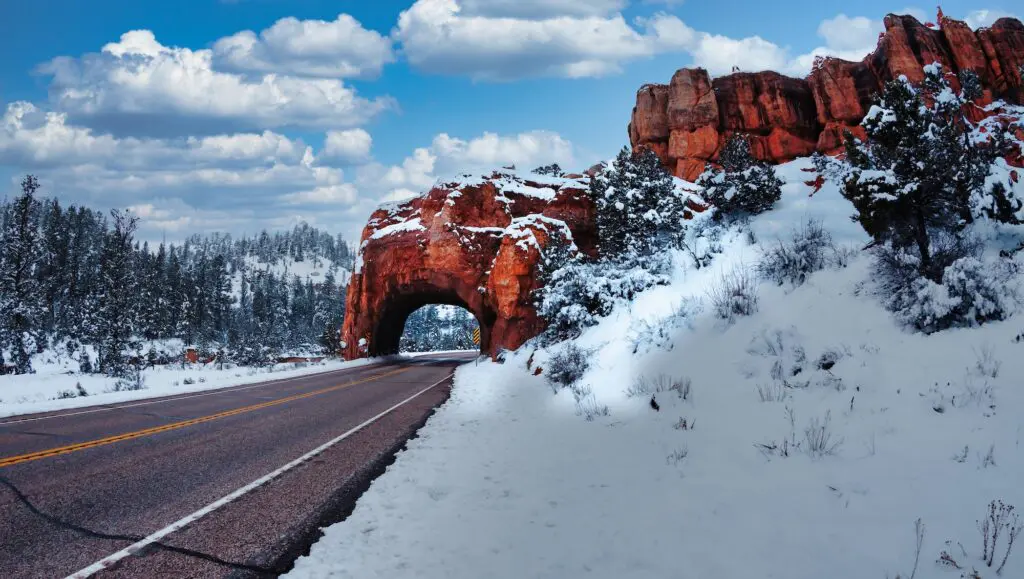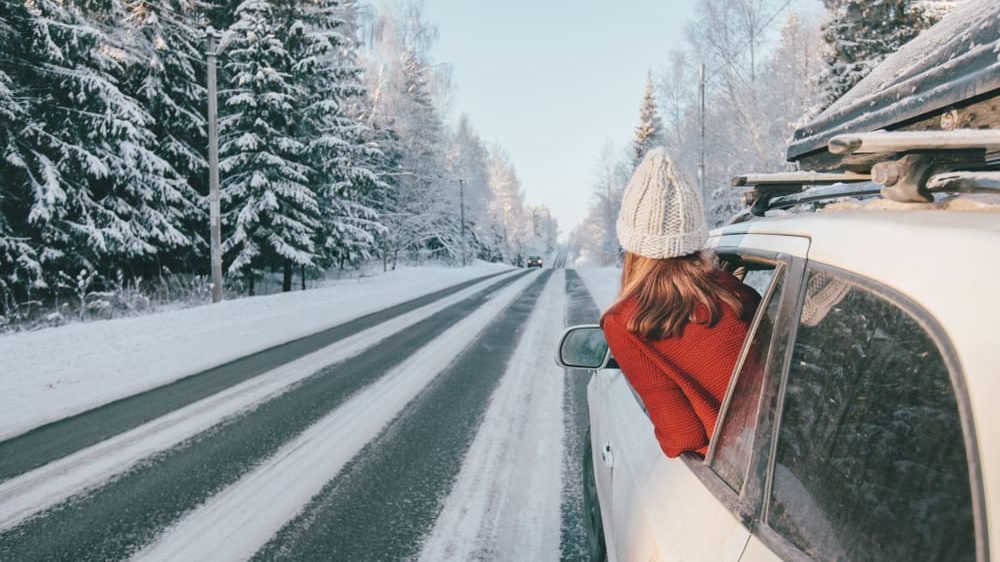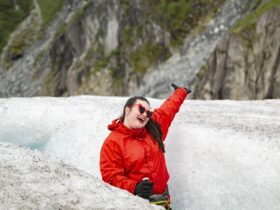I love a good winter road trip. Hitting the road at this time of year is an antidote to feeling cooped up, feeling warm in a car feels cozy, and there are so many great places you can go at this time of year.
But, winter road trips come with their own challenges. If you’re somewhere snowy, you should make sure your vehicle is up to the task. You’ll want to keep an eye on the weather on the trip, and you’ll need to make sure your car is tuned up, stocked up, and ready to go.
Winter Road Trip Tips

Driving anywhere in the cold weather and winter months requires special considerations. I spoke with Elizabeth Carey from AAA Western and Central New York to find out her best tips for cold weather road trips.
LIFE ON THE ROAD: 10 Best RV Road Trip Vacations for Families
1. Know Before You Go
Before anything else, it’s important to know about the conditions where you’re headed. Are you driving through or to an area that’s prone to lake effect snow? What’s the weather forecast during your trip? Are there any road closures along the way? Check the National Weather Service website for area road conditions, including regional winter weather advisories and storm watches, and download a good weather app to make sure you’re prepared.
BEST TRIP EVER: 50 Best Family Vacation Ideas for All Ages
If you’re headed to a national or state park (which, btw, can be extra amazing in winter) or a ski resort, keep in mind that you may be driving in areas where there are fewer services like gas stations as well as spotty cell service, so you’ll want to be extra diligent about your advance planning.
2. Test Your Battery
Nothing’s worse than the car not starting when everyone’s ready to go. If your engine’s slow to start or the lights dim when starting, it may be time for a new battery.
Most car batteries last three to five years, so if your battery is more than three years old, get it checked before a cold weather road trip. A mechanic can easily test the battery and charging system. Make sure the battery terminals and cable ends are free from corrosion and the connections are tight. Finally, make sure you have jumper cables on hand and know how to use them.
3. Check Your Lights
This is a good idea for anyone who drives at night, but too few of us actually take the time to check our car lights. It gets dark early on a winter road trip, so be sure that your headlights, taillights, brake lights, turn signals, and emergency flashers are all working. Replace any burnt-out bulbs before hitting the road, and throw in a working flashlight while you’re at it.
FIND A DEAL: 12 Best Hotel Booking Sites for Cheap Prices
4. Measure Air Pressure in Your Tires
Tires are probably the single most important part of safe winter driving. Make sure all four tires have the proper tread for the best traction while driving in potentially snowy condition. If you live in (or are heading to) an area with heavy winter weather, snow tires will provide the best traction. Regular, all-season tires work well in light to moderate snow conditions, too, provided they have enough tread.
Tip: Put a penny in your tire tread. If you see all of Lincoln’s head, it’s time to replace the tire.
AAA recommends replacing any tire whose tread is worn to 2/32 of an inch or less. One way to tell is to place a penny in the tread; if you see all of Lincoln’s head, the tire needs to be replaced. Don’t forget to make sure your tires are properly inflated, too. As the temperature drops, so does the tire pressure, typically one PSI for every 10 degrees. Under-inflated tires can affect braking distance, steering, and handling. Look for the proper tire pressure in your owner’s manual or the tire information sticker in the driver’s door jamb.
5. Check Your Wiper Blades and Fluid Levels
Make sure your wiper blades can clear your windshield, and replace any blade that leaves streaks or misses spots. Fill-up the windshield washer reservoir with fluid that won’t freeze when the temperature drops. Winter de-icer fluids are formulated to prevent the solution from freezing, and also contains chemicals that melt ice and frost.
BEST CAR RENTALS: 10 Best Car Rental Booking Sites for Cheap Prices
Don’t forget the engine coolant/antifreeze when checking fluid levels as well. Antifreeze lowers the freezing point of the engine’s liquid coolant system preventing the car from overheating.
6. Pack Your Winter Gear, but Don’t Wear it While Driving
Staying warm in cold temperatures is important: Make sure you have coats, scarves, gloves, boots, and hats with you, but take them off while you’re driving. The bulky coats limit arm movements, gloves decrease sensing steering wheel feedback, and large boots can interfere with the pedals. For infants in child seats, those puffy winter coats can cause car seat restraints to not fit securely. Pack the winter gear close at hand, but save the layers for the outdoors.
7. Stock an Emergency Kit
Don’t leave home without a proper car emergency kit that includes some basic items like a first aid kit, snacks (for both humans and any pets), ice scraper with brush, basic tools (screwdrivers, pliers, wrench), warning flares, cloths or paper towels, some drinking water, and an emergency blanket in case you find yourself stranded in some bad winter weather.
8. Give Your Car a Checkup
Before any major winter road trip, AAA recommends taking your vehicle to a mechanic for a thorough checkup of the brakes, drive belts, engine hoses, and all fluids (transmission, brake, and power steering). Fill the gas tank before you head out, and try not to drop below a quarter tank when you’re on the road.
9. Keep Emergency Numbers Handy
Make sure you have important phone numbers for emergency services programmed into your phone, and don’t forget to bring a car charger for your phone or tablet as well. Good numbers to have on hand include any roadside assistance service you might use, highway patrol, hotels you might be staying at en route, and family or friends who you’ll be seeing.
10. Use Extra Care When Driving in the Snow
If you’re out on your drive and get caught in a snow squall, don’t panic. Here are some basic tips for staying safe in snowy driving conditions.
- Drive slowly and keep your speed down to account for decreased traction.
- Accelerate and decelerate slowly in order to avoid skids.
- Increase your following distance to five or six seconds to account for the longer distance needed to stop.
- When braking, keep your heel on the floor and apply firm, steady pressure on the brake pedal.
- If possible, don’t stop when driving up a hill, as it can be difficult to get moving again on an icy road. However, don’t power up hills either. Applying extra gas on the snow-covered roads will only make your wheels spin.
- Make sure all the windows of your car are clear of snow before you start driving.
11. Pack a Shovel and Sand (Grit)
If you get stuck in the snow (or get plowed in), you’ll be glad you packed a small shovel to dig yourself out. A bag of some sort of grit (sand, salt, cat litter) will help your tires grab on icy surfaces as well as give some extra weight in the back of the car.
More from FamilyVacationist:
- 11 Family Road Trip Ideas Every Kid Will Love
- 11 Guided Tour Companies That Offer Trips around the World
- 15 Best All-Inclusive Resorts in the U.S.













